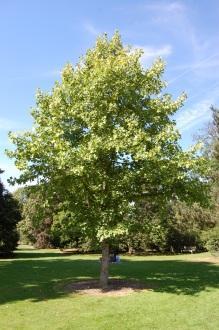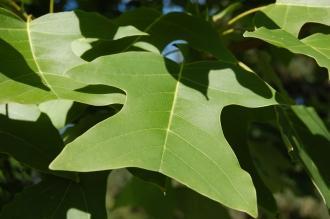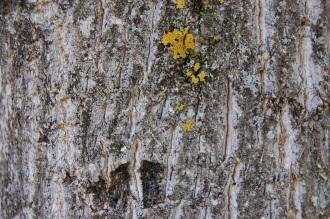
Liriodendron chinense (08/09/2012, Kew Garden, London)
Position: Full sun
Flowering period: Late spring to early summer
Soil: Moist, well drained
Eventual Height: 40m
Eventual Spread: 20m
Hardiness: 7a – 9b
Family: Magnoliaceae
Liriodendron chinense is a large, upright, deciduous tree with a broadly conical habit. Its mid green leaves have four lobes, are up to 22cm long and 25cm across. Its leaves turn yellow in autumn before they fall. Its trunk may achieve a diameter of up to 1.2m. Its gray bark has shallow vertical ridges. Its yellow/ green flowers are up to 10cm across, have nine tepals and have a faint fragrance of cucumber. Its fruit is a cone like aggregate of sumara, these are up to 9cm long. Its roots are deep and spreading.

Liriodendron chinense Leaf (08/09/2012, Kew Garden, London)
Liriodendron chinense, commonly known as the Chinese Tulip Tree, is native to central and southern China and northern Vietnam. Liriodendron chinense is becoming rare in its natural habitat and is classified as Near Threatened (NT) according to the IUCN Red List.
The etymological root of the binomial name Liriodendron is derived from the Greek lirio meaning ‘iris’ and dendron meaning ‘tree’. Chinense is derived from the Latin chinensis meaning ‘ from China’.
The landscape architect may find Liriodendron chinense useful as a large upright specimen tree, with attractive autumn color.

Liriodendron chinense Bark (08/09/2012, Kew Garden, London)
Ecologically, Liriodendron chinense is of little interest to UK wildlife.
Liriodendron chinense prefers moist, deep, fertile, well-drained soils. It tolerates most pH of soil, although it prefers a slightly acidic pH of soil.
Liriodendron chinense requires little maintenance.

